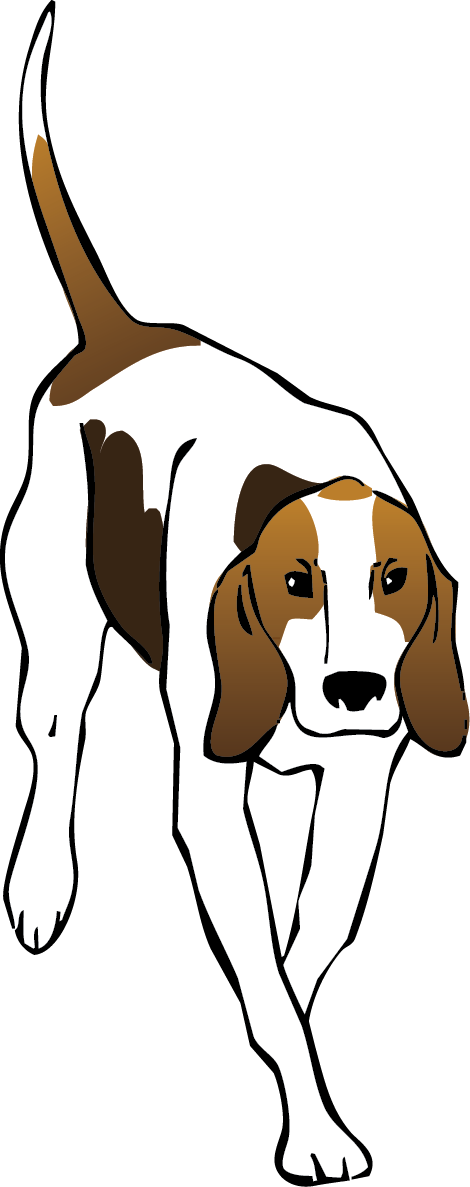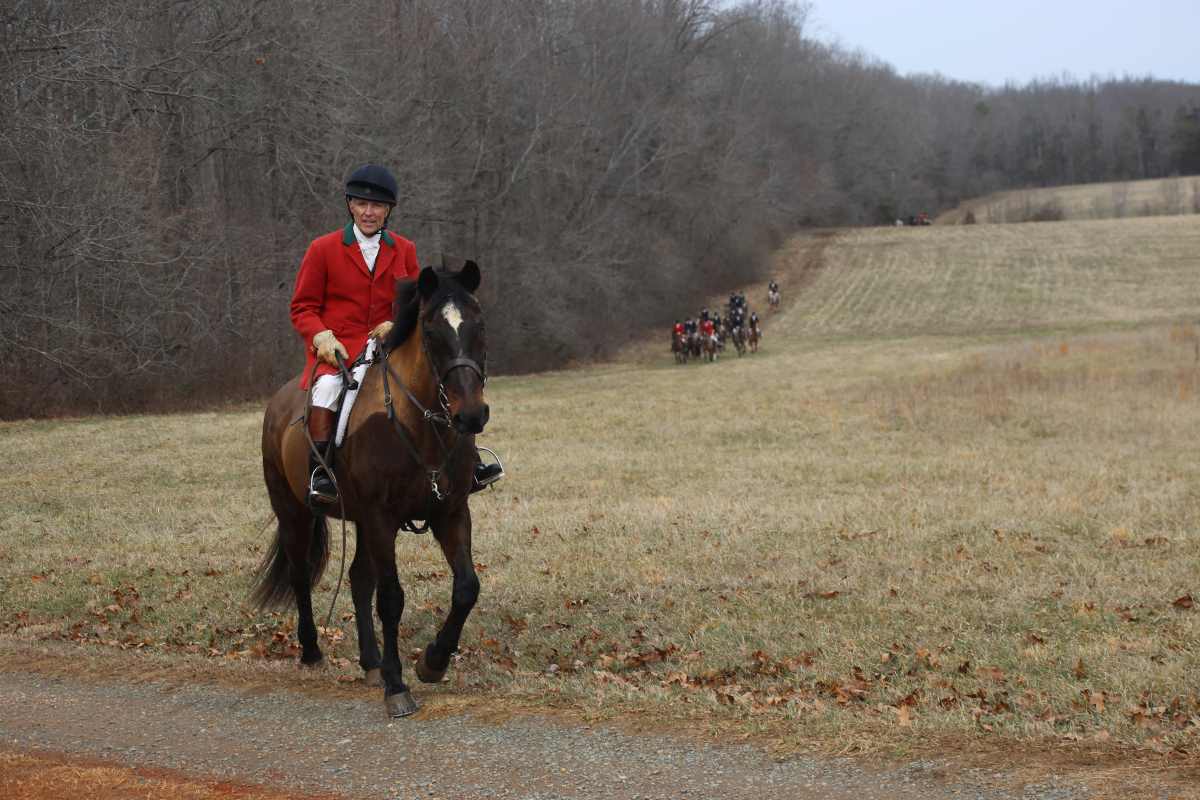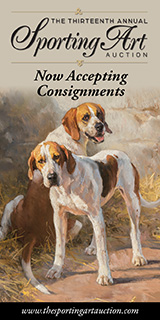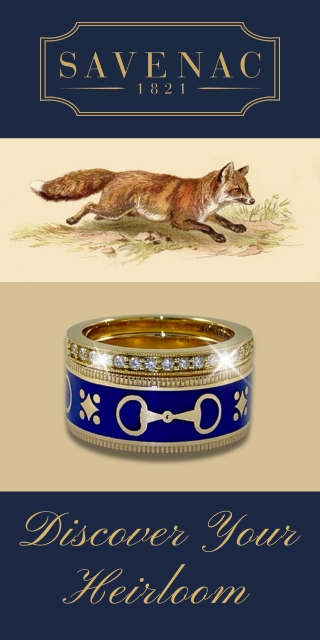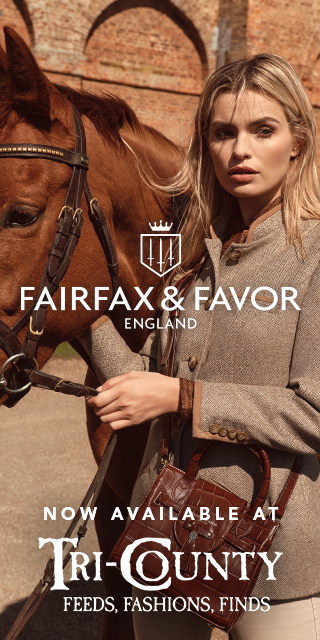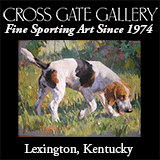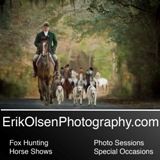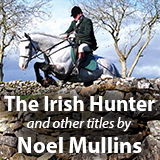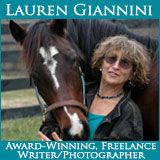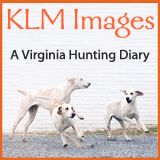whipper-in
A Whipper-In Lays Down His Whip
Barclay Rives decided that at the end of this 2023-2024 season, he would retire from hunting with Keswick Hunt Club in Virginia. Rives has been whipping-in for 53 years with Keswick, and he is a prolific writer (his book called “See You at Second Horses” is a personal favorite). To meet Barclay is to experience the most gentle and charming smile. I was privileged to interview him at Keswick’s Closing Meet party this past March.
Read More
The Second Whip
Illustration by Gilbert HollidayOver he goes, with a crash and a rattle,
Hound couples clinking, ’gainst saddle and thigh;
Over he goes, and the light of the battle
Gleams like a spark in his eager young eye.
Twigs of the hawthorn fly backward together,
Meeting again with an ominous swish;
Over he goes, landing light as a feather,
One with his horse and quick as you’d wish.
Kinds and condition of fences don’t matter,
Straight as a ramrod he rides at them all;
Over he goes with a bang and a clatter,
Knocking loose stones off the top of the wall.
Advice From a Junior Whipper-In
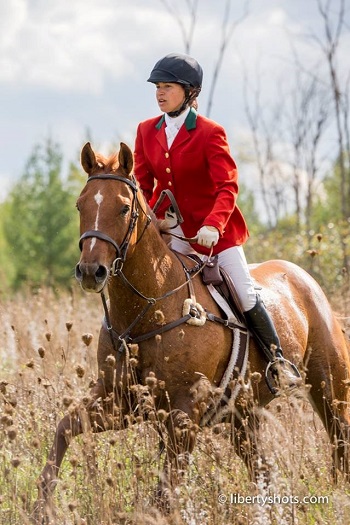 Here’s astute, peer-to-peer advice for juniors aspiring to become honorary hunt staff. I can’t help but wonder how many huntsmen out there would love to have Carmen on his/her staff!
Here’s astute, peer-to-peer advice for juniors aspiring to become honorary hunt staff. I can’t help but wonder how many huntsmen out there would love to have Carmen on his/her staff!
We, juniors, are the future of foxhunting. It is our responsibility to be knowledgeable and to keep this fantastic sport alive and traditional.
Have you ever peered past the first Field Master at those tiny white specs in the distance—the hounds—and wondered what's going on up there, what that blast of the horn meant, where that scarlet-clad rider is galloping off to in such a hurry? Ever think about whipping-in?
What to Think About Before You Decide to Whip-In
Whipping-in can be the most exhilarating, amazing adventure ever, or it can be the most terrifying, stressful experience ever. It largely depends on how you handle the thrills and horrors that being a whip sends your way.
Whipping-in doesn't only take place on your horse in the hunt field. It takes place in the kennels, in the stables, at home with a mountain of books, and in the mud on your backside watching your mount vanish into the distance.
Blue Ridge Huntsman Guy Allman Returns to England
Once again the time of year has arrived when hunts and huntsmen contemplating change make their decisions known—one to the other. Foxhunting Life will feature at least some of these huntsmen’s personal transitions through the coming months.
Nancy Kleck photo
Guy Allman, popular huntsman for the Blue Ridge Hunt (VA) for the past three seasons, received an offer he couldn’t refuse. He’ll return to England—home for him and his wife, Fran—to carry the horn for the Bicester with Waddon Chase Foxhounds. Guy will succeed huntsman Patrick Martin, who is retiring after twenty-two seasons hunting the pack.
The condition, fitness, and biddability of the Blue Ridge hounds testify to Allman’s work ethic. He spends a great deal of time training puppies early on, so by the time the season starts they are ready to enter, off the couples, all at once. On the first day of the season, every hound to be entered is out with the pack. And it’s a big pack, typically twenty-five to thirty couple, virtually every hound in kennels capable of walking on four legs.
Also on the first day of hunting, every hound is fit not only for the chase but for the late-summer weather as well. Allman wants hounds as oblivious to the heat as he appears to be. There are to be no excuses.
See You at Second Horses
See You at Second Horses, Barclay Rives, Aterlerix Press, New York, 2014, Paperback, illustrated, 184 pages, $13.50, available at retail outlets including Horse Country Saddlery, Warrenton, VirginiaThe foxes! Oh, the foxes! When Barclay Rives undertook a marathon of foxhunting in 1999, when he went out with nine English hunts in ten days, it seemed like there was a fox popping out of every covert.
Rives, an honorary whipper-in for the Keswick and Bull Run Hunts (VA), writes about his English sporting adventure in See You at Second Horses, a delightful read that puts us galloping behind some great packs in the glory days before the infamous Hunting Act of 2004 banned hunting with hounds in the traditional manner in England and Wales.
Rives is an avid hunter who once hunted one hundred days a season, sometimes going out with Keswick in the morning and Bull Run in the afternoon. Saying he was gung-ho is an understatement. He jumped at the chance to join his friends Grosvenor and Rosie Merle-Smith to hunt with packs dating back to the 1700s: the Quorn (twice), the Cottesmore, the Fernie, and others, including a foot pack—the High Peak Harriers—after rabbits.
See You at Second Horses
This hunt report—a short but informative excerpt from Chapter 3 of Barclay Rive’s new book, See You at Second Horses—harks back fifteen years to when Barclay accompanied Rosie and Grosvenor Merle-Smith to England. The book recounts their hunting adventures during that trip and is available from Horse Country Saddlery, Warrenton, Virginia.
At the time, Grosvenor was Master and huntsman of the Bull Run Hunt (VA), and Barclay whipped-in to him. Barclay also whipped-in to the Keswick Hunt (VA)—sometimes to both hunts on the same day when Keswick met in the morning and Bull Run in the afternoon!
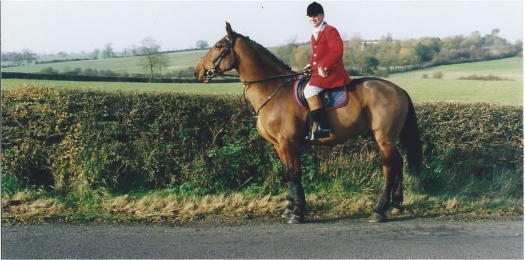 The author on Bruno at the Fernie meet at Billesdon / Rosie Merle-Smith photo
The author on Bruno at the Fernie meet at Billesdon / Rosie Merle-Smith photo
Julie and Colin brought our horses down the ramp out of the box. We had our first experience of what became a familiar routine: stepping up the ramp and using it as a mounting block for the horse led up beside it. I usually had to shorten my stirrups. Colin had to hold on to the horse’s head until I was done, because they were ready to go as soon as they felt weight in the saddle. Julie gave me instructions as I mounted a big bay.
“This is Bruno. He prefers a longer rein to a shorter one. He hunts with the Fernie every Saturday, so he knows his job.” This was her diplomatic way of telling me to stay off of the horse’s mouth and let him take care of me. I thought Bruno looked like he should be pulling a cart, but I was ignorant. He was a brilliant field hunter. An excellent teacher, Bruno was what American horse dealers call a packer, meaning he could pack me around as if I were a sack of grain. He was calm at checks, but ready to run and jump when the need arose. Sporting author Michael Clayton in Endangered Species reports that English foxhunters say the ideal hunting horse should have “the head of a duchess and the arse of a cook.” Bruno had plenty of muscle behind, and while his head was hardly elegant, he possessed beautiful brains.
Grosvenor, Rosie and I headed down the road where hounds had gone. Julie called to us, “See you at Second Horses.”
Vaughn Clatterbuck, Whipper-In to Twelve Virginia Huntsmen
Vaughn Clatterbuck signals a view for the Blue Ridge hounds across his Bartley Farm // Nancy Kleck photo Vaughn Clatterbuck, who whipped-in to twelve Virginia huntsmen, died at home on his cattle farm in Millwood, Virginia at age seventy-six on September 24, 2014 after a lengthy illness. Among those huntsmen to whom Vaughn whipped-in are the late Bay Cockburn, MFH and huntsman of the Loudoun West Hunt, and the late huntsman Jim Atkins. Vaughn later served as Field Master for the Snickersville Hounds in Middleburg, always showing his field a good time, no matter the scenting conditions. In 1968, after his father sold the family farm, Vaughn partnered with his cousin to start Bonded Carriers, Inc., which grew into the largest independent trucking company in West Virginia. The company was a real family operation involving a sibling, several cousins, his daughter and his son. Bonded employed well over a hundred employees and served customers up and down the East Coast. In 2008, after forty years of operation, the company was sold on account of Vaughn’s ill health. He retired to his farm, where he raised Hereford and black baldy cattle. His Clarke County farm was a regular and popular fixture for the Blue Ridge Hunt, and Vaughn was usually seen waving from his ATV while watching hounds. He was mowing pasture fields the week before he died. Vaughn was a strong horseman and a knowledgeable whipper-in. Because he loved his foxhunting so, he was always a joy to be with in the field. His wife Wendell Hawken Clatterbuck is a brilliant poet, whom this writer has had the honor to publish several times, both in Covertside and in Foxhunting Life. A service of Thanksgiving for Vaughn’s life will be held on Saturday, September 27 at 3:00 pm at Christ Church, Millwood. In lieu of flowers, memorials may be sent to Christ Church, PO Box 153, Millwood, VA 22646 for the Clatterbuck Scholarship Fund for underprivileged children, or to the Ability Fitness Center, c/o Jared Blaney, 11111 Sunrise valley Drive, Reston, VA 20190 for a special needs facility. Posted September 25, 2014
Read More
Excerpt from “Reynard the Fox”
This joyful image of foxhounds arriving at the meet, conscious all the while of the attentive whipper-in, is an excerpt from the chapter, Hounds, in John Masefield’s epic poem, Reynard the Fox, written in 1919. John Masefield was Poet Laureate of the United Kingdom from 1930 to 1967. [Note: Dansey is the whipper-in, and Maroon is his horse.]
There was a general turn of faces,
The men and horses shifted places,
And around the corner came the hunt,
Those feathery things, the hounds, in front,
Intent, wise, dipping, trotting, straying,
Smiling at people, shoving, playing,
Nosing to children’s faces, waving
Their feathery sterns, and all behaving,
One eye to Dansey on Maroon.
How They Do It at Belle Meade
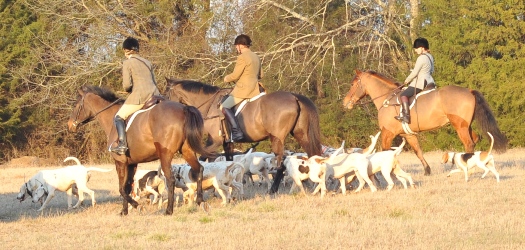 Epp Wilson, MFH and huntsman of the Belle Meade Hunt brings hounds to the first draw to kick off "Gone Away with the Wind" Hunt Week. Whippers-in Lucy Bell (left) and Natalie Gilmore flank the pack. / Lauren R. Giannini photo
Epp Wilson, MFH and huntsman of the Belle Meade Hunt brings hounds to the first draw to kick off "Gone Away with the Wind" Hunt Week. Whippers-in Lucy Bell (left) and Natalie Gilmore flank the pack. / Lauren R. Giannini photo
“We have arranged to have ten coyotes on standby for your hunting pleasure today,” announced Joint-MFH Charlie Lewis as he welcomed guests to the opening meet of Belle Meade’s “Gone Away with the Wind” Hunt Week. It was Monday, January 27, 2014 in Thomson, Georgia. The footing was perfect and the sun was shining.
The following day it snowed, closing schools, paralyzing the Atlanta area, and prompting the governor to declare a state of emergency. The Belle Meade hosts were resilient, however, improvising substitute activities for members and guests for the very few events that had to be modified.
Hunt Week guests had come from the Blue Ridge Hunt (VA), Bull Run Hunt (VA), Golden’s Bridge Hounds (NY), Marlborough Hunt (MD), Millbrook Hunt (NY), Montreal Hunt (PQ), Moore County Hounds (NC), the Potomac Hunt (MD), Toronto and North York Hunt (ON), and the Whiskey Road Hounds (SC).
The Meet
The Belle Meade hounds typically meet at three o’clock in the afternoon. In the warmish environs of north Georgia, Senior Master and huntsman Epp Wilson likes to hunt as temperatures are dropping and scent is improving. Of course it often results in riders hacking back in the dark, and even jumping fences after sunset—an adventure in its own right for many followers!
Heather Player to Carry the Horn at Norfolk
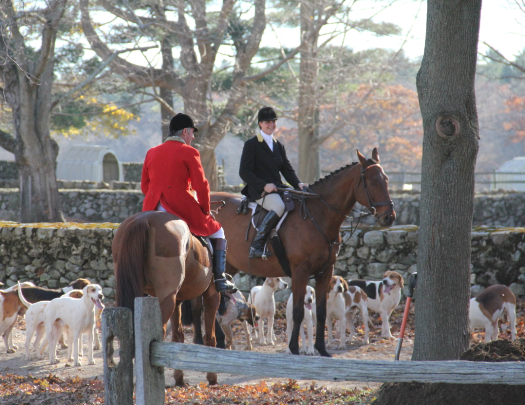 Heather Player carried the horn and Norfolk huntsman John Elliott whipped-in to her at the All New England Hunt hosted by Myopia in 2010. / Mary Marks photo
Heather Player carried the horn and Norfolk huntsman John Elliott whipped-in to her at the All New England Hunt hosted by Myopia in 2010. / Mary Marks photo
Myopia Hunt whipper-in Heather Player will move inland from Boston’s North Shore to become huntsman for the nearby Norfolk Hunt next season. Founded in the late 1800s, both hunts are among North America’s most venerable hunting institutions, and both have been hunting the drag since that time.
Heather grew up hunting with Myopia under the tutelage of well-known North Shore trainers Patrick and Barbara Keough.
“When I was around seven years old I started riding with Patrick and Barbara at the Myopia Hunt Club Stables,” said Heather. “Patrick started me hunting at eleven, and from
then on that’s all I wanted to do. I would do the local horse shows but never enjoyed it as much as hunting. I earned my Junior Colors at fourteen. My first paying job was at the Myopia Hunt Club at sixteen, riding and hunting horses.
